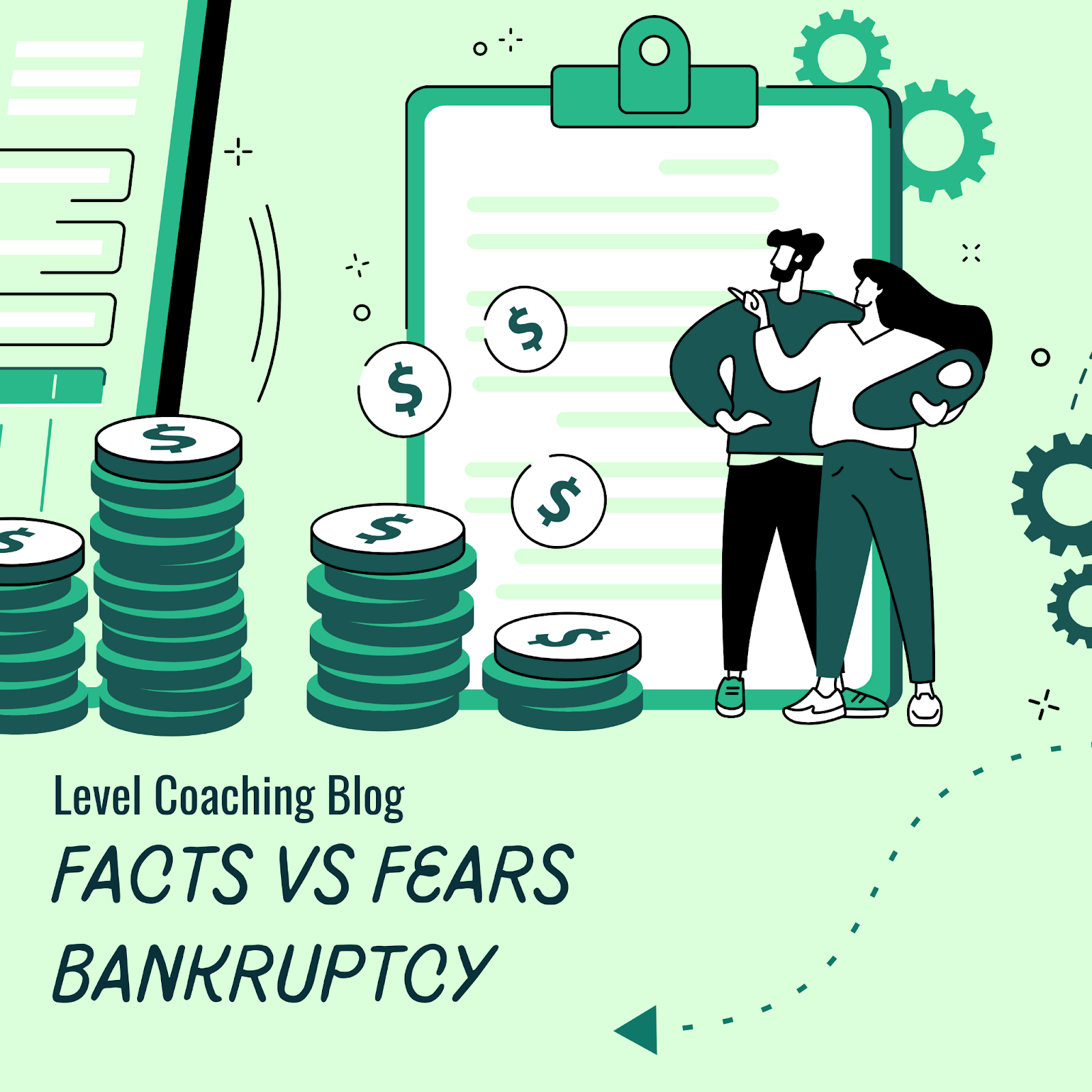
14 Apr The Decision to File Bankruptcy: Facts vs. Fears
The word “bankruptcy” often sparks anxiety, shame, or fear—but what if we told you that bankruptcy isn’t the end? At Level Coaching, we believe it can be the beginning of a healthier financial life when used with strategy, education, and support. If you’re drowning in debt, behind on payments, or facing legal threats, bankruptcy may be the reset button you didn’t know you needed.
This guide walks you through the pros, cons, and common fears of bankruptcy, while helping you decide if it’s the right move for your financial future.
What Is Bankruptcy?
Bankruptcy is a legal process that provides relief from overwhelming debt. It allows individuals or businesses to either eliminate or restructure what they owe under the protection of federal law. The goal? A clean slate and a path to rebuild.
There are different types (or “chapters”) of bankruptcy, but the two most common for individuals are:
- Chapter 7: Liquidation bankruptcy—used to eliminate unsecured debts
- Chapter 13: Reorganization bankruptcy—used to repay part of your debt over time
Facing the Fear Factor
Let’s tackle the fears that stop people from exploring bankruptcy—even when it might be the smartest option:
Fear 1: “I’ll lose everything.” Truth: Most people who file Chapter 7 keep their homes, vehicles, and retirement accounts, thanks to state and federal exemptions.
Fear 2: “It will ruin my credit forever.” Truth: Yes, bankruptcy affects your credit—but you can rebuild. Many clients receive credit offers within 6–12 months post-discharge.
Fear 3: “It means I failed.” Truth: Bankruptcy is a legal right—not a moral judgment. Life happens. Job loss, medical emergencies, and divorce can derail even the most responsible person.
Fear 4: “I’ll never get approved for anything again.” Truth: Many people who file bankruptcy go on to buy homes, cars, and start businesses with better financial footing than before.
Pros of Filing Bankruptcy
- Stops collections, garnishments, and lawsuits
- Wipes out credit cards, medical bills, and personal loans
- Offers a fresh start free from unmanageable debt
- Rebuilds credit faster than doing nothing
- Improves mental health and reduces financial stress
Cons of Filing Bankruptcy
- Damages your credit score (temporarily)
- May not eliminate student loans or recent tax debts
- Public record of filing
- May require selling non-exempt assets (in Chapter 7)
Chapter 7 vs. Chapter 13: What’s the Difference?
Chapter 7: Liquidation
- Best for low-income individuals with little to no assets
- Discharges most unsecured debt in 3–6 months
- Stops lawsuits and collections
Chapter 13: Reorganization
- Allows you to keep your home or car while catching up on missed payments
- Requires a 3–5 year repayment plan
- Great for people with steady income who don’t qualify for Chapter 7
Some states have specific exemptions and rules, so it’s critical to speak to a local bankruptcy attorney to understand your rights and what you can protect.
Is Bankruptcy the Right Move for You?
Bankruptcy is not for everyone—but if you identify with the following, it might be time to consider it:
- You’re more than 90 days behind on multiple debts
- You’ve maxed out credit cards and are only making minimum payments
- Collectors are threatening legal action or garnishing your wages
- Your total unsecured debt exceeds half your annual income
- You feel emotionally and mentally drained by your financial situation
At Level Coaching, we help clients walk through a decision tree to determine if they’ve exhausted all other options—like debt settlement or consolidation—before turning to bankruptcy. If it’s the best choice, we’ll help you move forward with confidence and a plan.
What Happens After Bankruptcy?
This is where your financial comeback begins. After your discharge:
- Create a Budget That Works – Use your new financial breathing room to build a sustainable lifestyle based on your current income.
- Rebuild Your Credit – Start with a secured credit card or credit-builder loan. Always pay on time and keep your balances low.
- Set Savings Goals – Begin rebuilding your emergency fund. Even $500 can prevent future financial emergencies.
- Stay Educated & Supported – Consider working with a financial coach to help you stay on track and continue your upward momentum.
- Avoid High-Risk Credit Offers – After filing, you may be bombarded with high-interest loan offers. Avoid jumping back into debt. Focus on low-risk credit tools and long-term goals.
Final Thoughts: Bankruptcy Doesn’t Define You—Your Next Steps Do
Bankruptcy isn’t the end of your financial journey—it’s the reset button that allows you to build again, smarter and stronger. When used intentionally and followed by solid coaching and budgeting practices, bankruptcy can be a strategic tool in your long-term financial wellness plan.
At Level Coaching, we believe in empowering you with the truth, not fear tactics. If you’re wondering whether bankruptcy is right for you, let’s talk. Our coaches can walk you through your options, connect you with trusted legal resources, and help you build your comeback story—step by step.
Take the first step toward clarity and control. Contact Level Coaching today to schedule a free consultation and discover what financial freedom really looks like—for you.
Written by Nichole Miller,
April 2025

